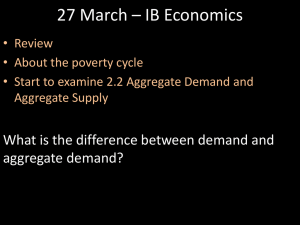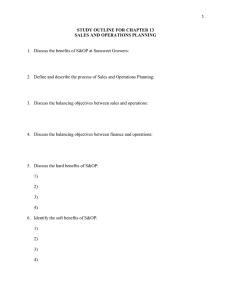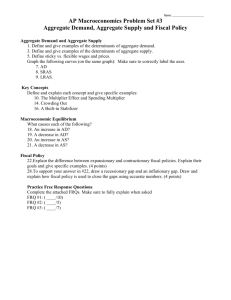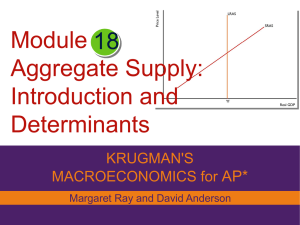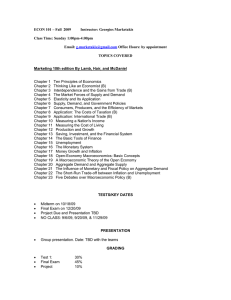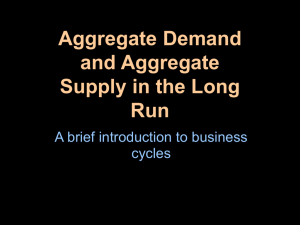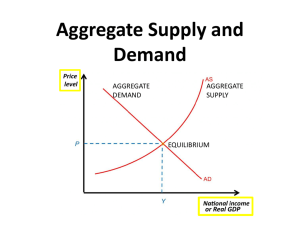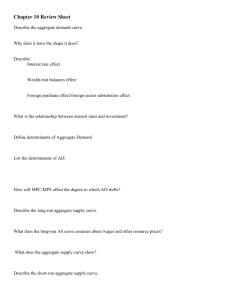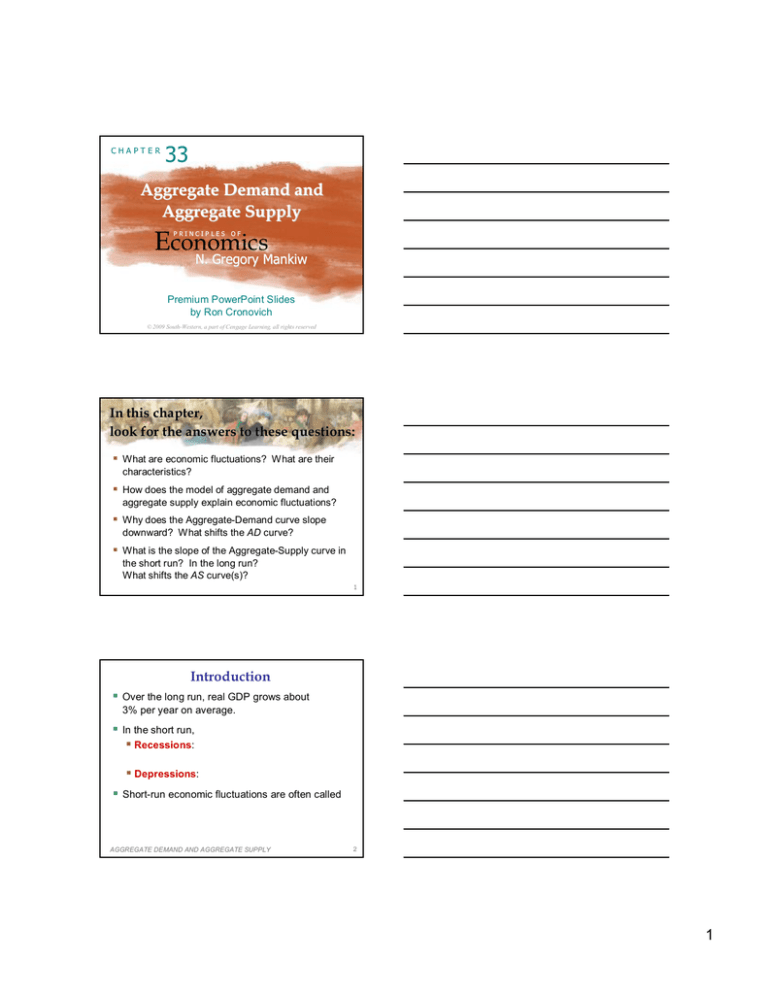
CHAPTER
33
Aggregate Demand and
Aggregate Supply
Economics
P RINCIP LES OF
N. Gregory Mankiw
Premium PowerPoint Slides
by Ron Cronovich
© 2009 South-Western, a part of Cengage Learning, all rights reserved
In this chapter,
look for the answers to these questions:
§ What are economic fluctuations? What are their
characteristics?
§ How does the model of aggregate demand and
aggregate supply explain economic fluctuations?
§ Why does the Aggregate-Demand curve slope
downward? What shifts the AD curve?
§ What is the slope of the Aggregate-Supply curve in
the short run? In the long run?
What shifts the AS curve(s)?
1
Introduction
§ Over the long run, real GDP grows about
3% per year on average.
§ In the short run,
§ Recessions:
§ Depressions:
§ Short-run economic fluctuations are often called
AGGREGATE DEMAND AND AGGREGATE SUPPLY
2
1
Three Facts About Economic Fluctuations
14,000
12,000
10,000
U.S.
U.S. real
real GDP,
GDP,
billions
billions of
of 2000
2000 dollars
dollars
8,000
The
The shaded
shaded
bars
bars are
are
recessions
recessions
6,000
4,000
2,000
0
1965 1970 1975 1980 1985 1990 1995 2000 2005 2010
3
Three Facts About Economic Fluctuations
2,500
2,000
Investment
Investment spending,
spending,
billions
billions of
of 2000
2000 dollars
dollars
1,500
1,000
500
0
1965 1970 1975 1980 1985 1990 1995 2000 2005 2010
4
Three Facts About Economic Fluctuations
12
10
Unemployment
Unemployment rate,
rate,
percent
percent of
of labor
labor force
force
8
6
4
2
0
1965 1970 1975 1980 1985 1990 1995 2000 2005 2010
5
2
Introduction, continued
§ Explaining these fluctuations is difficult, and the
theory of economic fluctuations is controversial.
§ Most economists use the model of
aggregate demand and aggregate supply
to study fluctuations.
§ This model differs from the classical economic
theories economists use to explain the long run.
AGGREGATE DEMAND AND AGGREGATE SUPPLY
6
Classical Economics—A Recap
§ The previous chapters are based on the ideas of
classical economics, especially:
§ The Classical Dichotomy, the separation of
variables into two groups:
§ Real – quantities, relative prices
§ Nominal – measured in terms of money
§ The neutrality of money:
AGGREGATE DEMAND AND AGGREGATE SUPPLY
7
Classical Economics—A Recap
§ Most economists believe classical theory
describes the world in the long run,
but not the short run.
§ In the short run,
§ To study the short run, we use a new model.
AGGREGATE DEMAND AND AGGREGATE SUPPLY
8
3
The Model of Aggregate Demand
and Aggregate Supply
9
AGGREGATE DEMAND AND AGGREGATE SUPPLY
The Aggregate-Demand (AD) Curve
P
Y
10
AGGREGATE DEMAND AND AGGREGATE SUPPLY
Why the AD Curve Slopes Downward
P
Y = C + I + G + NX
Assume
To understand
the slope of AD,
must determine how
P2
P1
AD
Y2
AGGREGATE DEMAND AND AGGREGATE SUPPLY
Y1
Y
11
4
The Wealth Effect (P and C )
Suppose P rises.
Result:
AGGREGATE DEMAND AND AGGREGATE SUPPLY
12
The Interest-Rate Effect (P and I )
Suppose P rises.
Result:
AGGREGATE DEMAND AND AGGREGATE SUPPLY
13
The Exchange-Rate Effect (P and NX )
Suppose P rises.
§ U.S. interest rates rise (the interest-rate effect).
Result:
AGGREGATE DEMAND AND AGGREGATE SUPPLY
14
5
The Slope of the AD Curve: Summary
An increase in P
§ the wealth effect
(C falls)
P
P1
AD
§ the interest-rate
effect (I falls)
Y
Y1
§ the exchange-rate
effect (NX falls)
15
AGGREGATE DEMAND AND AGGREGATE SUPPLY
Why the AD Curve Might Shift
P
P1
Example:
A stock market boom
makes households feel
wealthier, C rises,
the AD curve shifts right.
AD2
AD1
Y1
Y2
AGGREGATE DEMAND AND AGGREGATE SUPPLY
Y
16
Why the AD Curve Might Shift
§ Changes in
§ Changes in
AGGREGATE DEMAND AND AGGREGATE SUPPLY
17
6
Why the AD Curve Might Shift
§ Changes in
§ Changes in
18
AGGREGATE DEMAND AND AGGREGATE SUPPLY
ACTIVE LEARNING 1
The AggregateAggregate-Demand curve
What happens to the AD curve in each of the
following scenarios?
A. A ten-year-old investment tax credit expires.
B. The U.S. exchange rate falls.
C. A fall in prices increases the real value of
consumers’ wealth.
D. State governments replace their sales taxes
with new taxes on interest, dividends, and
capital gains.
19
The Aggregate-Supply (AS) Curves
The AS curve shows
P
Y
AGGREGATE DEMAND AND AGGREGATE SUPPLY
21
7
The Long-Run Aggregate-Supply Curve (LRAS)
The natural rate of
output (YN) is
P
YN is also called
potential output
or
full-employment
output.
Y
22
AGGREGATE DEMAND AND AGGREGATE SUPPLY
Why LRAS Is Vertical
YN determined by
An increase in P
P
LRAS
P1
YN
Y
23
AGGREGATE DEMAND AND AGGREGATE SUPPLY
Why the LRAS Curve Might Shift
P
LRAS1
Example:
Immigration
increases L,
causing YN to rise.
AGGREGATE DEMAND AND AGGREGATE SUPPLY
YN
Y
24
8
Why the LRAS Curve Might Shift
§ Changes in
§ Changes in
25
AGGREGATE DEMAND AND AGGREGATE SUPPLY
Why the LRAS Curve Might Shift
§ Changes in
§ Changes in
26
AGGREGATE DEMAND AND AGGREGATE SUPPLY
Using AD & AS to Depict LR Growth and
Inflation
Over the long run,
Result:
P
LRAS1980
P1980
AD1980
Y1980
AGGREGATE DEMAND AND AGGREGATE SUPPLY
Y
27
9
Short Run Aggregate Supply (SRAS)
P
The SRAS curve
Over the period
of 1-2 years,
an increase in P
P2
P1
Y
Y1
28
AGGREGATE DEMAND AND AGGREGATE SUPPLY
Why the Slope of SRAS Matters
P
LRAS
If AS is vertical,
fluctuations in AD
do not cause
fluctuations in output
or employment.
If AS slopes up,
AD1
Y1
AGGREGATE DEMAND AND AGGREGATE SUPPLY
Y
29
Three Theories of SRAS
In each,
§ some type of market imperfection
§ result:
AGGREGATE DEMAND AND AGGREGATE SUPPLY
30
10
1. The Sticky-Wage Theory
§ Imperfection:
Nominal wages are sticky in the short run,
§ Firms and workers set the nominal wage in
advance based on PE, the price level they
expect to prevail.
AGGREGATE DEMAND AND AGGREGATE SUPPLY
31
1. The Sticky-Wage Theory
§ If P > PE,
§ Hence, higher P causes higher Y,
so the SRAS curve slopes upward.
AGGREGATE DEMAND AND AGGREGATE SUPPLY
32
2. The Sticky-Price Theory
§ Imperfection:
§ Due to
§ Examples: cost of printing new menus,
the time required to change price tags
§ Firms
AGGREGATE DEMAND AND AGGREGATE SUPPLY
33
11
2. The Sticky-Price Theory
§ Suppose the Fed increases the money supply
unexpectedly. In the long run, P will rise.
§ In the short run, firms without menu costs
§ Firms with menu costs
Meantime, their prices are relatively low,
§ Hence, higher P is associated with higher Y,
so the SRAS curve slopes upward.
AGGREGATE DEMAND AND AGGREGATE SUPPLY
34
3. The Misperceptions Theory
§ Imperfection:
§ If P rises above PE, a firm sees its price rise
before realizing all prices are rising.
§ So, an increase in P can cause an increase in Y,
making the SRAS curve upward-sloping.
AGGREGATE DEMAND AND AGGREGATE SUPPLY
35
What the 3 Theories Have in Common:
In all 3 theories, Y deviates from YN when
P deviates from PE.
AGGREGATE DEMAND AND AGGREGATE SUPPLY
36
12
What the 3 Theories Have in Common:
YY == YYNN ++ aa(P
(P –– PPEE))
P
SRAS
the expected
price level
PE
Y
YN
37
AGGREGATE DEMAND AND AGGREGATE SUPPLY
SRAS and LRAS
§ The imperfections in these theories are
temporary. Over time,
§ In the LR,
38
AGGREGATE DEMAND AND AGGREGATE SUPPLY
SRAS and LRAS
YY == YYNN ++ aa(P
(P –– PPEE))
P
LRAS
SRAS
In the long run,
PE = P
and
Y = YN.
PE
YN
AGGREGATE DEMAND AND AGGREGATE SUPPLY
Y
39
13
Why the SRAS Curve Might Shift
Everything that shifts
LRAS shifts SRAS, too.
P
LRAS
Also,
SRAS
If PE rises,
workers & firms set
higher wages.
PE
At each P,
Y
YN
40
AGGREGATE DEMAND AND AGGREGATE SUPPLY
The Long-Run Equilibrium
In the long-run
equilibrium,
P
LRAS
SRAS
PE = P,
Y = YN ,
and unemployment
is at its natural rate.
PE
AD
YN
Y
AGGREGATE DEMAND AND AGGREGATE SUPPLY
41
Economic Fluctuations
§ Caused by
§ Four steps to analyzing economic fluctuations:
1. Determine whether the event shifts AD or AS.
2. Determine whether curve shifts left or right.
3. Use AD-AS diagram to see how the shift
changes Y and P in the short run.
4. Use AD-AS diagram to see how economy
moves from new SR eq’m to new LR eq’m.
AGGREGATE DEMAND AND AGGREGATE SUPPLY
42
14
The Effects of a Shift in AD
Event: Stock market crash
P
LRAS
SRAS1
P1
A
AD1
Y
YN
43
AGGREGATE DEMAND AND AGGREGATE SUPPLY
Two Big AD Shifts:
1. The Great Depression
U.S. Real GDP,
billions of 2000 dollars
From 1929-1933,
§ money supply
900
850
800
§ stock prices
750
700
650
§Y
600
1934
1933
1932
1931
1929
§ u-rate
1930
550
§P
44
AGGREGATE DEMAND AND AGGREGATE SUPPLY
Two Big AD Shifts:
2. The World War II Boom
From 1939-1944,
§ govt outlays
U.S. Real GDP,
billions of 2000 dollars
2,000
1,800
1,600
1,000
AGGREGATE DEMAND AND AGGREGATE SUPPLY
1944
1943
1942
800
1941
§ unemployment
1,200
1940
§P
1,400
1939
§Y
45
15
ACTIVE LEARNING 2
Working with the model
§ Draw the AD-SRAS-LRAS diagram
for the U.S. economy
starting in a long-run equilibrium.
§ A boom occurs in Canada.
Use your diagram to determine
the SR and LR effects on U.S. GDP,
the price level, and unemployment.
46
ACTIVE LEARNING 2
Answers
Event: Boom in Canada
47
The Effects of a Shift in SRAS
Event: Oil prices rise
P
LRAS
SRAS1
P1
A
AD1
YN
AGGREGATE DEMAND AND AGGREGATE SUPPLY
Y
48
16
Accommodating an Adverse Shift in SRAS
If policymakers do nothing,
P
LRAS
SRAS2
Or, policymakers could
P2
P1
SRAS1
B
A
AD1
Y2 YN
Y
49
AGGREGATE DEMAND AND AGGREGATE SUPPLY
The 1970s Oil Shocks and Their Effects
1973-75
1978-80
Real oil prices
+ 138%
+ 99%
CPI
+ 21%
+ 26%
Real GDP
– 0.7%
+ 2.9%
# of unemployed
persons
+ 3.5
million
+ 1.4
million
AGGREGATE DEMAND AND AGGREGATE SUPPLY
50
John Maynard Keynes, 1883-1946
§ The General Theory of Employment,
Interest, and Money, 1936
§ Argued recessions and depressions
can result from inadequate demand;
policymakers should shift AD.
§ Famous critique of classical theory:
The long run is a misleading guide
to current affairs. In the long run,
we are all dead. Economists set themselves
too easy, too useless a task if in tempestuous seasons
they can only tell us when the storm is long past,
the ocean will be flat.
AGGREGATE DEMAND AND AGGREGATE SUPPLY
51
17
CONCLUSION
§ This chapter has introduced the model of
aggregate demand and aggregate supply,
which helps explain economic fluctuations.
§ Keep in mind:
§ In the next chapter, we will learn how
policymakers can affect aggregate demand
with fiscal and monetary policy.
AGGREGATE DEMAND AND AGGREGATE SUPPLY
52
18

